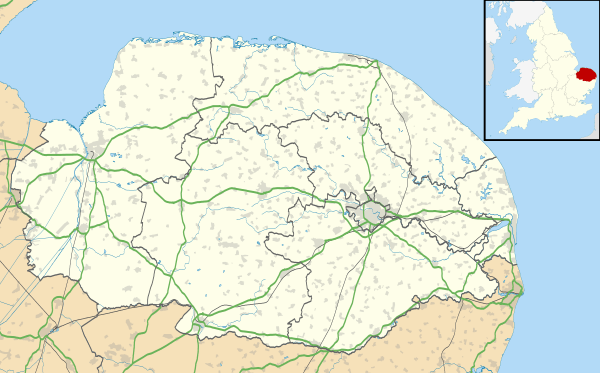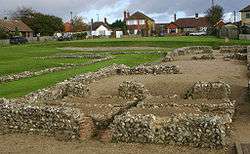Caister-on-Sea
Caister-on-Sea, also known colloquially as Caister and formerly Caister-next-Yarmouth, is a large village in Norfolk in England, United Kingdom, close to the large town of Great Yarmouth. It is a seaside resort and busy holiday destination on the "Golden Mile", with its main attraction being its sandy "Georgian Beach". It is home to Great Yarmouth race course.[1] At the 2001 census it had a population of 8,756 and 3,970 households,[2] the population increasing to 8,901 at the 2011 Census.[3] It used to be served by Caister-on-Sea railway station. There was also a Caister Camp Halt, opened in 1933 to serve the holiday camp mentioned below. However, both were closed in 1959, after which Great Yarmouth railway station, 4 km (2.5 mi) to the south, became the nearest station.[4] The wind farm at Scroby Sands has thirty 2–megawatt wind turbines, 2.5 km (1.6 mi) off shore.
| Caister-on-Sea | |
|---|---|
 Caister-on-Sea Location within Norfolk | |
| Population | 8,901 2011 Census |
| OS grid reference | TG512125 |
| District |
|
| Shire county | |
| Region | |
| Country | England |
| Sovereign state | United Kingdom |
| Post town | GREAT YARMOUTH |
| Postcode district | NR30 |
| Dialling code | 01493 |
| Police | Norfolk |
| Fire | Norfolk |
| Ambulance | East of England |
| UK Parliament | |
History

Caister's history dates back to Roman times. In around AD 200 a fort was built here as a base for a unit of the Roman army and navy. However its role as a fort appears to have been reduced following the construction of the Saxon Shore fort at Burgh Castle on the southern side of the estuary in the latter part of the 3rd century.
In the 1950s, a building near the south gate at Caister was excavated in advance of a housing development. These buildings certainly do not appear to be very military as they include a hypocaust and painted wall plaster as well as female jewellery, and it has been suggested that this building may have been an officer's house, or possibly a ‘seamen's hostel’ which may be a polite name for a brothel. The site appears to have been abandoned in the 5th century, but 150 Saxon burials have been found to the south of the enclosure.[5] The remains excavated in the 1950s are now managed by English Heritage and are open free of charge to the public as Caister Roman Site.
There has been an offshore lifeboat in the area since 1791.[6] It was used by a beach company to salvage ships wrecked on the sand banks. Between 1856 and 1969 lifeboats were operated by the RNLI. In the 1901 Caister lifeboat disaster, nine crew were lost while attempting a rescue during heavy seas. At the time it was said, "If they had to keep at it 'til now, they would have sailed about until daylight to help her. Going back is against the rules when we see distress signals like that".[7]
This response was translated by journalists to become the famous phrase "Caister men never turn back". A monument to the men lost in the disaster bearing this inscription stands in the village cemetery and a pub called the "Never Turn Back" is named after the incident.
Today, Caister is also host to a National Coastwatch Institution (NCI) Station.
21st century
There is a Haven caravan and holiday park near the coast. One of the oldest in the UK, it began as the "Great Yarmouth Social Club" in 1906.[8] In the 1950s and early 1960s, it used to be on both sides of the road. Opposite the beach was a dining room, paper shop, sports facilities and tourist chalets. These facilities were sold to a property developer who turned it into housing in the 1970s. In the 1980s a brand new holiday camp was opened, under the ownership of Ladbrokes, which was later sold to Warners in the 1990s.
References
- Ordnance Survey (2005). OS Explorer Map OL40 - The Broads. ISBN 0-319-23769-9.
- Office for National Statistics & Norfolk County Council (2001).Census population and household counts for unparished urban areas and all parishes. Retrieved 2 December 2005.
- "Parish population 2011". Retrieved 24 August 2015.
- "Railway Passenger Stations in England, Scotland and Wales: A Chronology" by M E Quick; 2005.
- A Guide to the Roman Remains in Britain by Roger Wilson (Constable)
- BBC Online. Caister Lifeboat
- Storey, Neil R. (1 November 2011). Little Book of Norfolk. The History Press. ISBN 9780752494609.
- Holiday camps at Seaside History. Accessed May 2008.